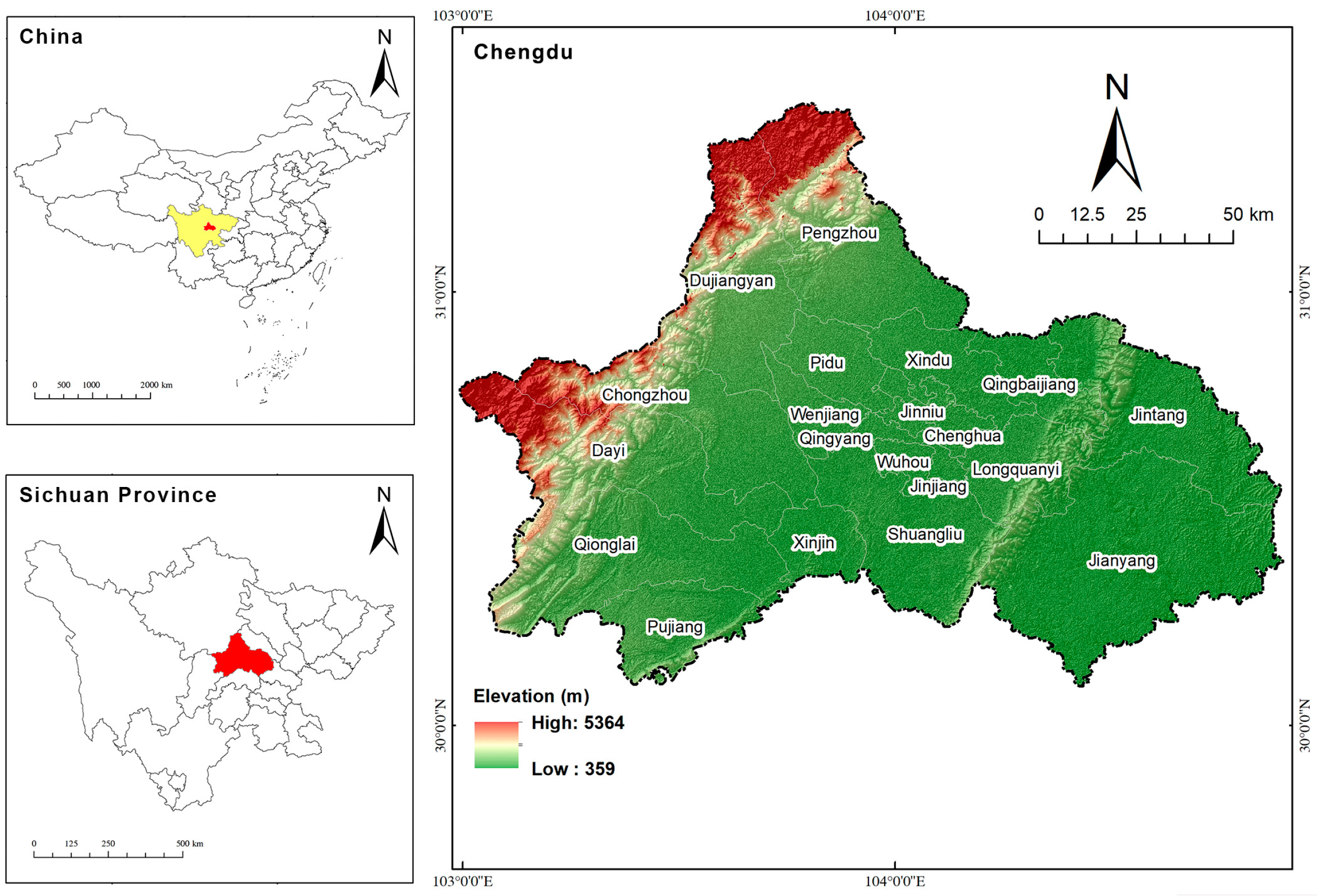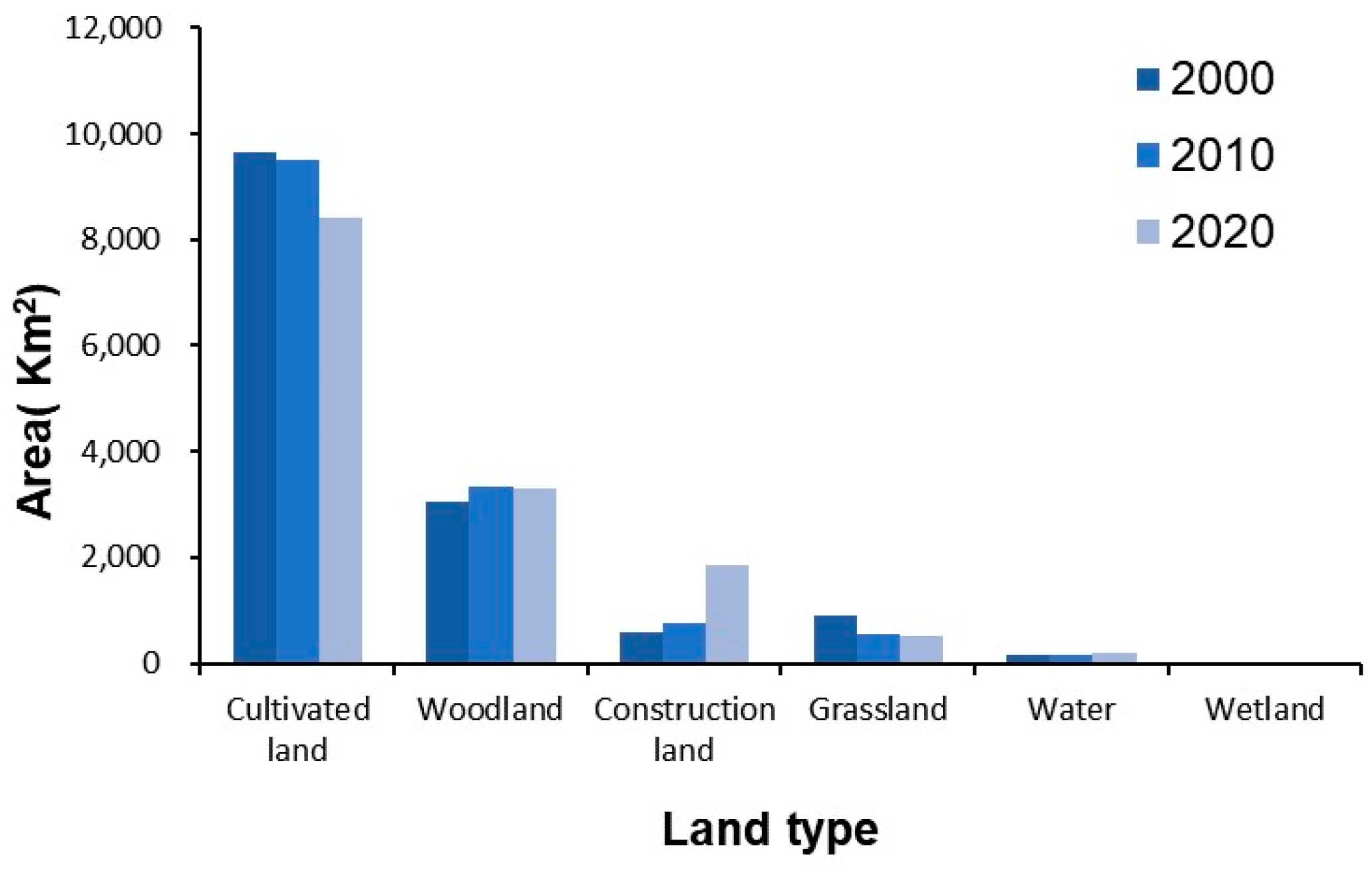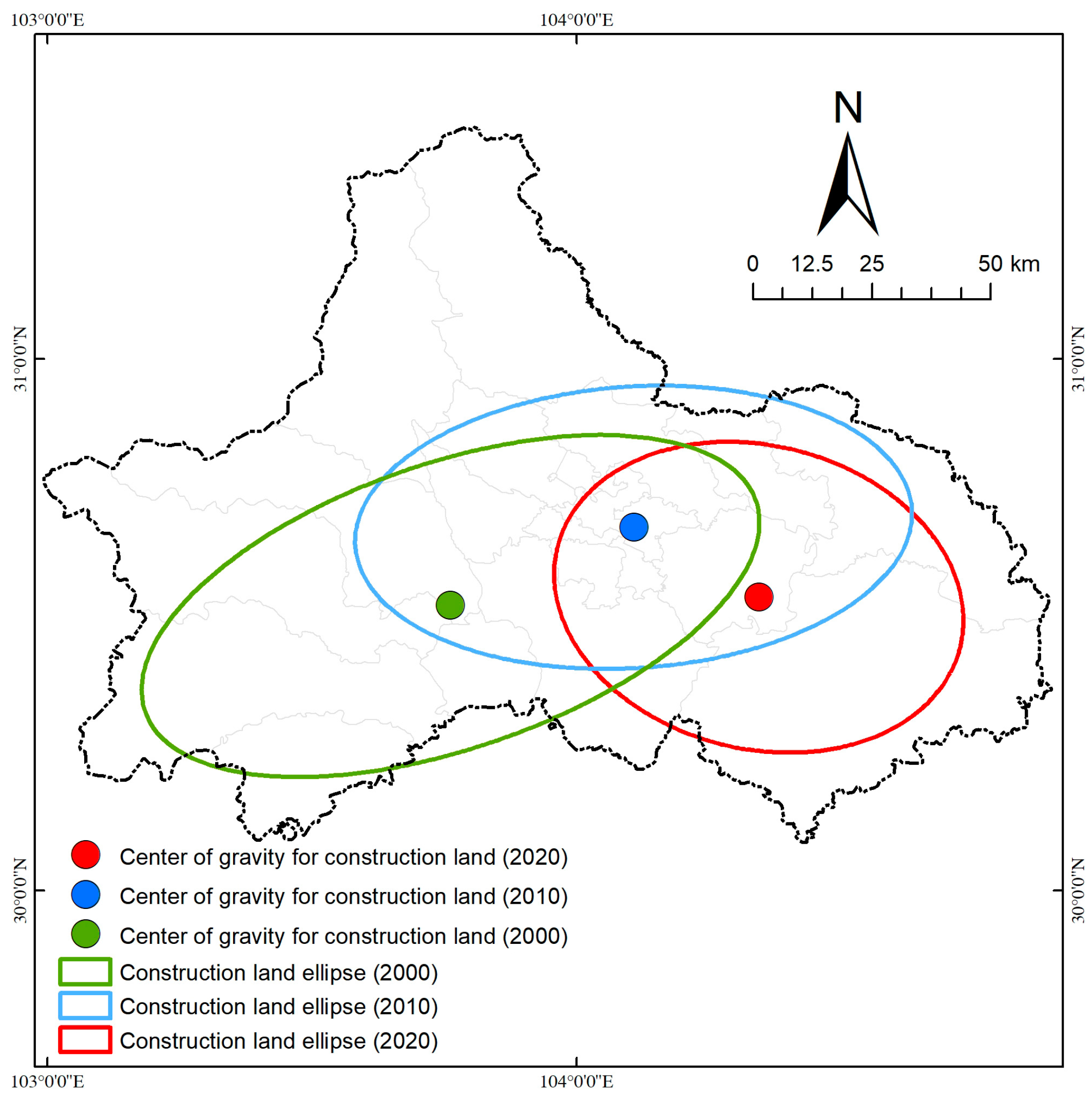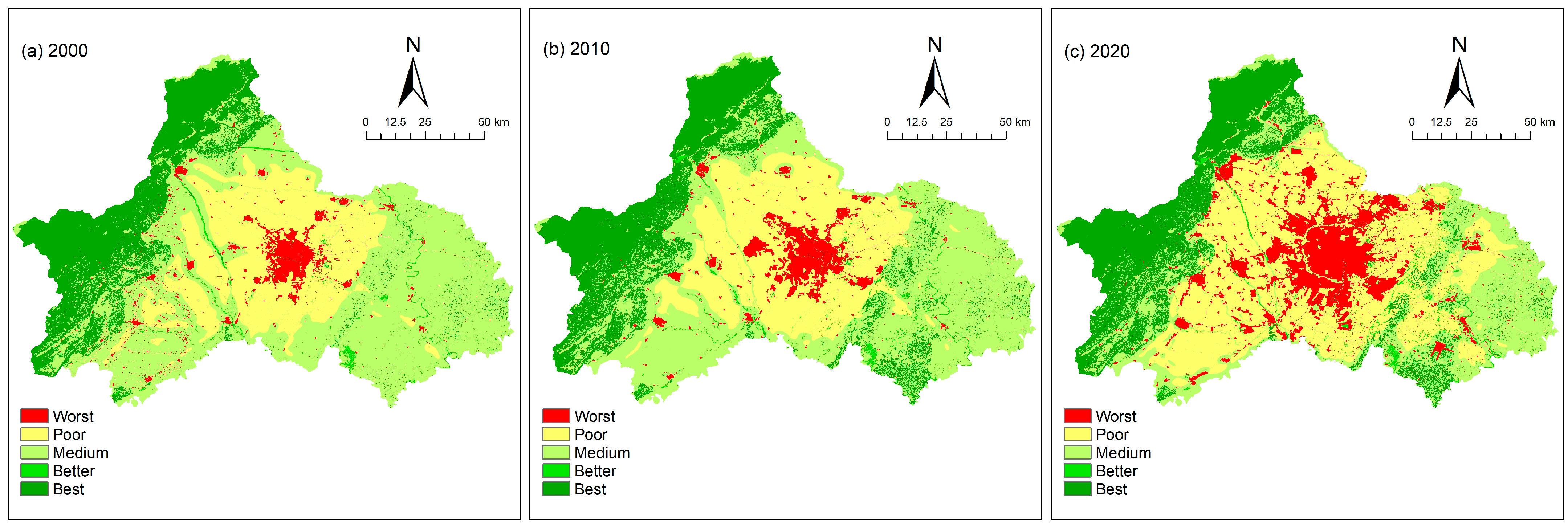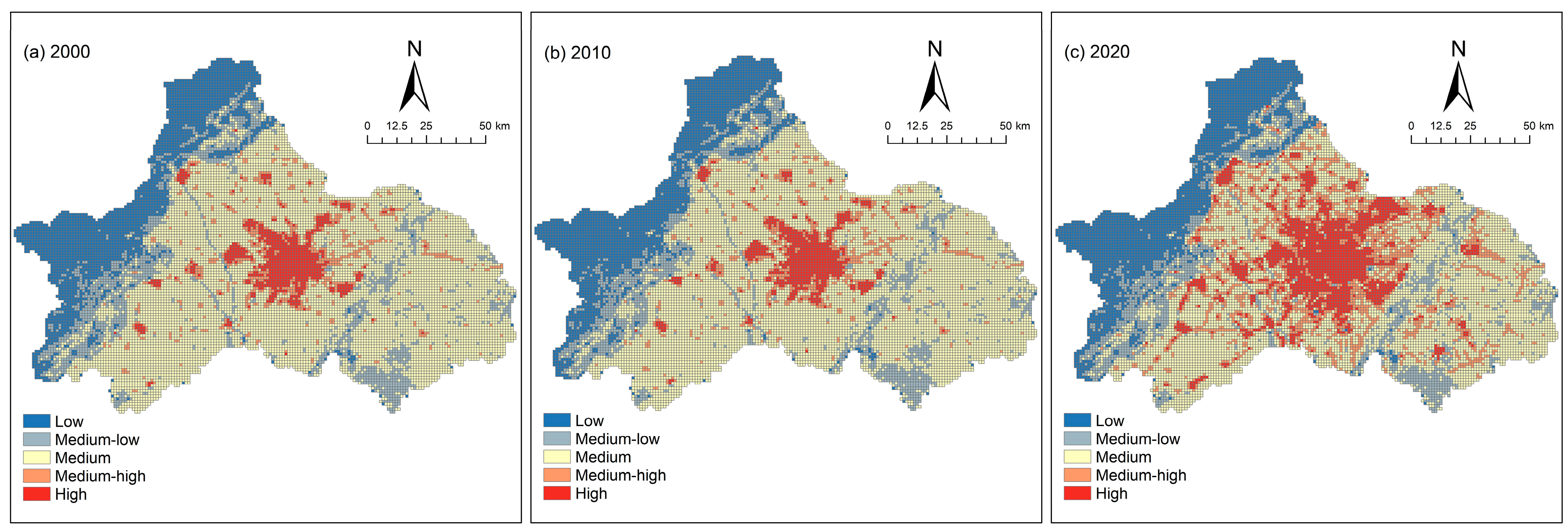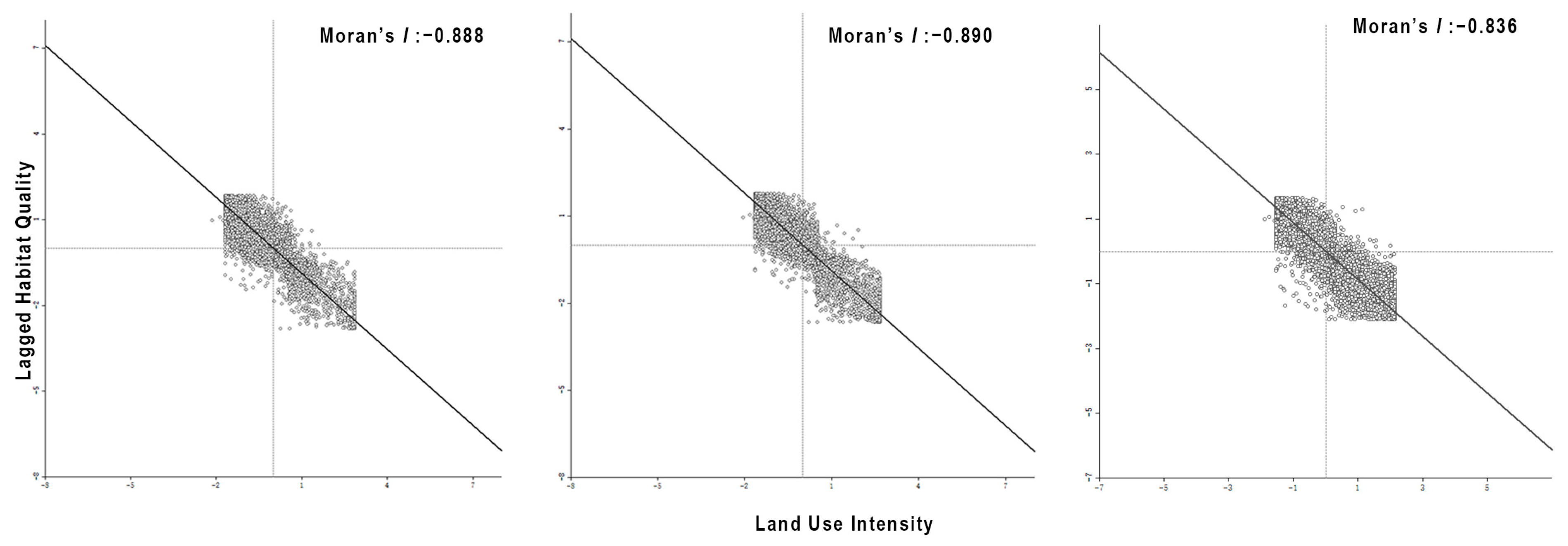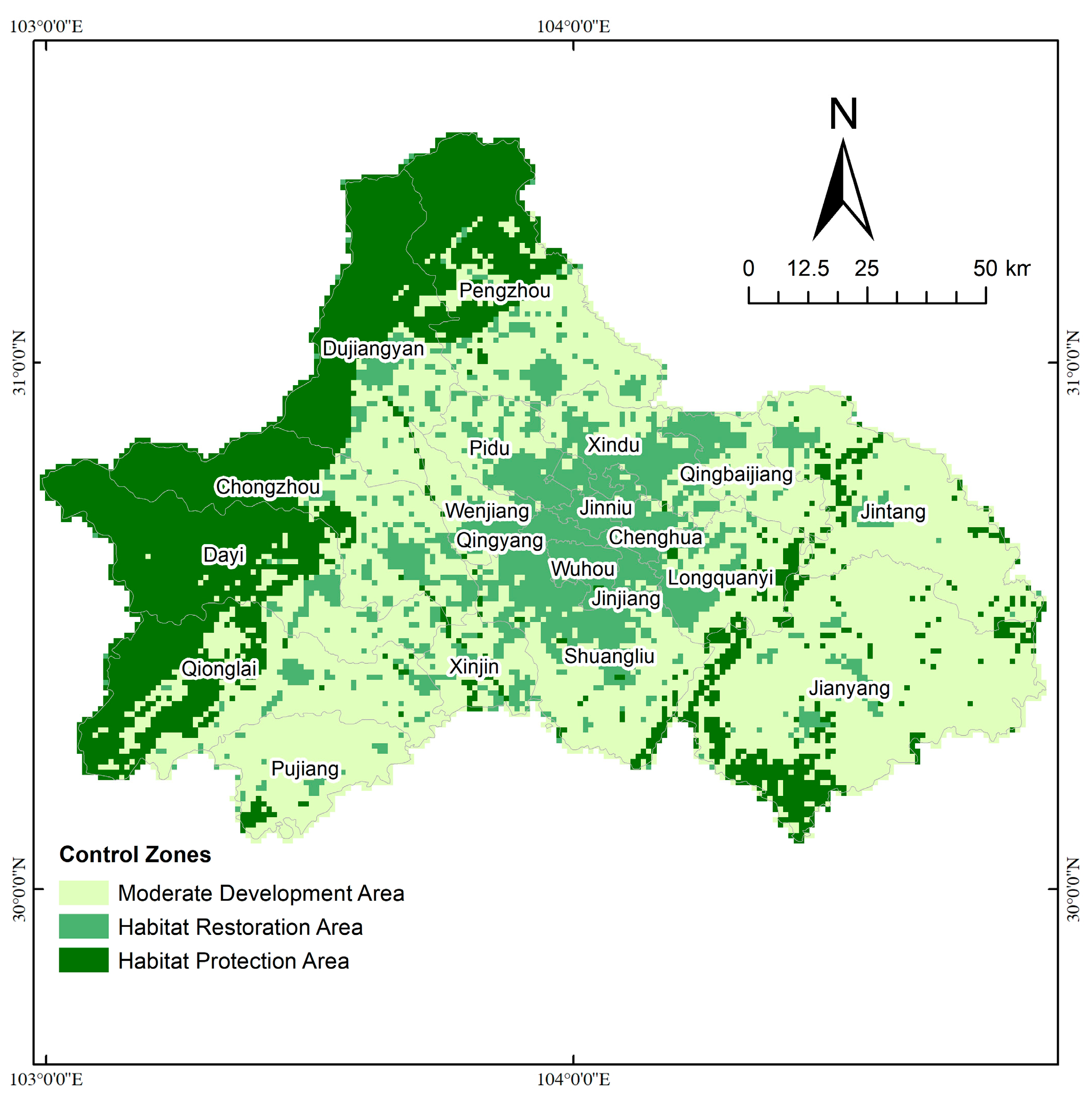1. Introduction
According to statistics, more than 4 billion people worldwide currently live in urban areas; the size of urban populations continues to increase, with 60% of the global population (nearly 5 billion people) expected to live in cities by 2030. [
1] The advancement of urbanization has led to an increase in human demand for ecosystem services in natural ecosystems [
2]; humans are meeting the demand for land for construction by changing land use types and through urban land expansion. Urban expansion is a process of land use change that transforms non-urban land into urban land. [
3,
4] Urban expansion is characterized by the systematic construction and improvement of large-scale settlements, industries, centers of economic activity, and the transportation networks that accompany them [
5]. However, economically oriented urban construction often neglects the protection of urban ecology. In recent years, the negative impacts of urban expansion on ecosystems have raised concerns. Urban expansion can affect ecological connectivity, ecosystem services, biodiversity, and urban river systems. Urban expansion has been shown to lead to loss of agricultural land [
6], reduction in wildlife habitats [
7], and biodiversity threats [
8]. The impacts of urban expansion on habitats are divided into direct and indirect impacts. Urban expansion changes the original land properties and encroaches on the surrounding land, directly compressing the original natural habitat space. Meanwhile, a series of development, infrastructure construction, noise, sewage, air pollution, and surface temperature increases brought by urban expansion also affect the surrounding natural habitats to a certain; this represents the indirect impact of urban expansion on ecological environments [
9,
10,
11]. Habitat fragmentation and degradation caused by urban expansion has become the main cause of regional habitat quality decline, biodiversity threats, and ecological security pattern destruction [
12,
13]; the final problem is also an important factor limiting sustainable urban development [
14]. Therefore, exploring the effects of urban expansion on habitat quality and integrating habitat concepts into urban planning are important for achieving sustainable urban development and protecting native species.
The academic term habitat was first introduced by the American scholar Grinnel in 1917 [
15]; habitat is defined as the spatial environment in which an organism lives. Habitat quality refers to the ability to provide suitable conditions for individuals and populations to survive [
16]. Urban habitat is regarded in this study as the spatial collection of all habitats within the urban city limits. Habitat quality can reflect the level of regional biodiversity and ecological services, as well as the quality of the human living environment [
17,
18]. Habitat space in cities provides living space for native species and the integrity of habitat structure and layout in cities is the basis for balanced urban ecosystems and good habitats. Habitat quality assessment was initially applied mainly to animal habitats and nature reserves [
19,
20] to study the habitat quality of single species or populations. More recently, paired with the development of technology and the prominence of urban ecological problems, some scholars began to shift from micro- and meso-scale studies to macro-scale studies of urban habitat quality. There are two main aspects of current research on habitat quality in cities; the first aspect is the impact of human activities and the environment on the habitat of a single species [
21,
22,
23,
24]. For example, Regan et al. assessed habitat quality in the San Diego region by tracking data for 10 species and found that urban construction fragmented urban habitats; however, when habitat fragments were large enough, regional biodiversity could be secure [
25]. It was also found that smaller blue–green spaces in cities (e.g., parks and squares) do not contribute much to urban biodiversity, compared to urban water ecosystems, large parks, and foothills, which provide better habitat spaces in cities [
26]. The second aspect is the impact of socioeconomic development, land use changes, and other influences on habitat quality due to urban human activities [
27,
28]. Jiang et al. analyzed the correlation between economic data, population density, and habitat quality in the Guangdong–Hong Kong–Macao Greater Bay Area and found that economic and population growth were negatively correlated with the habitat quality of the region [
29]. Han et al. found that the habitat quality in the Dongting Lake region showed fluctuations of “improvement–deterioration–stabilization–intensification of deterioration” with the change in land use type [
30]. Zhong et al. found that habitat quality began to show improvement after land remediation and planning guidance and that land remediation brought ecological benefits to the area [
31]. Xiang et al. found that urban land use change is the main cause of habitat quality degradation; therefore, their model simulated land use under different development scenarios in Tianjin and made habitat quality predictions, finding that urban habitat quality was superior under the ecological conservation scenario than other scenarios of development [
32]. The response of habitat quality to land use change has been commonly studied in previous research, but this approach does not provide a good integrated picture of the relationship between regional development and habitat quality. Therefore, this study introduces land use intensity to comprehensively reflect and quantify the land use changes in urban expansion; it also makes recommendations for future urban development based on the spatial correlation characteristics of land use intensity and habitat quality.
Early habitat quality assessments often used indicators. For example, Valero [
33] assessed the condition of river habitats by using the riparian zone vegetation index and river habitat index. Valero constructed a comprehensive index evaluation system to assess the habitat quality of the area; however, this research method ignored the impact of threat sources on the surrounding habitats. There are also scholars of ecology who have assessed the habitat quality of areas through field surveys by investigating the number of species as well as their spatial distribution [
34,
35]. This research method is good for making recommendations for species conservation but is more labor- and material-intensive. Some scholars have also studied the spatial relationship between habitats to assess habitat quality. For example, Young [
36] constructed a grid of Black Country, UK, and assessed habitat quality by measuring the spatial connectivity of habitats between grids and the degree of habitat fragmentation. Along with the maturity and integration of RS, GIS, GPS and other technologies, scholars have quantified the habitat quality by constructing models. At this stage, scholars have used the MAXENT [
37], SolVES [
38], ARIES [
39], HSI [
40], and InVEST [
41] models to measure habitat quality. Among them, the InVEST model is widely used with advantages over other models in terms of application cost, evaluation accuracy, and visual analysis [
42]. The habitat quality module of the InVEST model can be used to assess the habitat quality of a region by combining the habitat suitability of the habitat itself with the influence of the surrounding environment; the InVEST model also performs well in large-scale regional studies.
Chengdu is a provincial capital city, the core city of Chengdu–Chongqing Economic Circle, and an important central city in the western region. In the context of high-speed urbanization, the contradiction between urban development and the ecological environment is increasingly prominent, while land use guidance under the perspective of ecological protection is a necessary measure for sustainable urban development. Based on the InVEST model and land use intensity, this paper analyzes the dynamic changes of habitat quality under the influence of urban expansion from 2000 to 2020; it also explores the spatial correlation characteristics between habitat quality and land use intensity by using Geoda software. Finally, an ecologically oriented spatial control zoning of the city is proposed to provide reference for future urban development and ecological protection paths.
5. Discussion
The natural factors of the city determine the general ecological pattern, while human construction activities influence the habitat space. The assessment of habitat quality in Chengdu from 2000 to 2020 revealed that the distribution of habitat quality in Chengdu showed a distribution pattern of low habitat quality in the central part of the city and high habitat quality in the eastern and western parts of the city. Chengdu is located in the eastern part of the Sichuan Basin and contains a variety of terrain, including hills, mountains, and plains. The Longquan Mountains in the east and Longmen Mountains in the west provide good habitat space for Chengdu due to limited human disturbance and presently high habitat quality. The Chengdu Plain is an alluvial fan plain; the central plain area has been an important source of food and edible oil, and has been known as the “Land of Heaven”, since ancient times. Suitable construction conditions combined with deep cultural heritage have made the central region a concentrated area for urban construction. The high frequency of human construction activities in the central region also reduces the habitat quality in the central region.
Changes in habitat quality are a response to urban expansion. From 2000 to 2020, construction land in Chengdu continued to expand. Compared to the 34.12% increase in construction land in the first ten years of 2000–2010, the increase in construction land between 2010–2020 was 140.58%, an expansion rate 5.52 times faster than the previous decade. The expansion of cities continued to accelerate and the scale of construction land continued to increase. In the early high-speed development phase, ecology gave way to urban development. Changing land use types and habitat fragmentation due to urban expansion are important reasons for the decline in regional habitat quality. Urban expansion encroached on a large amount of cultivated land and grassland, and the overall habitat quality in 2000, 2010, and 2020 shows a decreasing trend. Due to the construction of the city, large areas of woodland in Wenjiang District have been converted to construction land; the magnitude and scale of habitat degradation is enormous. From 2010 to 2020, Chengdu vigorously developed the southern part of the city and, along with the construction of the Gaoxin South District, there was extensive degradation of regional habitat quality. In addition, it is worth noting that urban construction around the main stream of the Min River, the West River and the South River in the southwestern part of the city has led to a significant decline in habitat quality along the river. The spatial clustering of “low land use intensity–low habitat quality” (L–L) emerged along the river in the spatial correlation analysis; this represents the negative impact of urban expansion on the adjacent habitat space. As rivers are an important part of the ecosystem, urban construction in river areas should be strictly controlled in future urban planning to protect the river ecological corridors of the city. By analyzing the rate of urban expansion in Chengdu, it is found that the city has entered a rapid development phase since 2010, with the expansion of construction land being an inevitable trend. However, the impact of urban expansion on the habitat environment is negative; thus, urban construction should be controlled in future urban planning and urban land use guidance should be proposed to prevent disorderly urban expansion from destroying the quality habitat space of the city. These proposals would allow the ecological pattern of the city to be better protected and the sustainable development of the city to be realized. This study proposes spatial control suggestions for future urban development based on the spatial correlation between land use intensity and habitat quality. In the future, Chengdu should focus on protecting the two major ecological barriers, the Longmen Mountains in the east and the Longquan Mountains in the east, to protect the high-quality ecological space in the city. The western plains area is a concentrated area for agricultural production and an upstream area for urban water sources; thus, future development should focus on conservation to stabilize and optimize habitat quality. Habitat quality in the central plain area is low due to the high speed of urban construction in the studied period. In future urban planning, we should control the speed of urban construction and build green space within the city to restore the habitat quality of the region. Based on the analysis of urban expansion in Chengdu, it is found that the city entered a high-growth phase after 2010, with the expansion rate of the city being on a growth trend. It is also an effective path to protect the quality of urban habitats for the guidance of urban development in Chengdu. According to the analysis in
Section 4.4, the urban development zone of Chengdu under ecological protection is located in the eastern part of the Longquan Mountains, which echoes the construction policy of the “Chengdu–Chongqing twin-city economic circle” in recent years.
6. Conclusions
This study used the InVEST model to assess the habitat quality in Chengdu from 2000 to 2020 and found that the overall habitat quality in Chengdu was on a decreasing trend. Spatial correlation analysis of land use intensity and habitat quality using GeoDa software revealed a significant negative correlation between land use intensity changes due to urban expansion and habitat quality. The impact of urban expansion on habitats is divided into direct and indirect impacts. Urban expansion encroaches on surrounding cultivated and grassland areas, compressing natural habitat space, and directly degrading regional habitats; at the same time, a series of human activities of urban expansion also have negative impacts on adjacent habitat spaces, most notably along some rivers in the southwestern part of the city. Therefore, this study recommends a municipal control zoning proposal based on the mechanism of urban expansion on habitat and the current situation of land use intensity and habitat quality. This land use guidance can protect the original high-quality ecological space in the city, while also providing ecologically oriented sustainable development suggestions for the future development of the city.
This study uses a regional macro-analysis to study the overall habitat quality of the city; however, the green spaces, such as parks and squares, that exist in the urban space are also part of the spatial composition of the urban habitat. In the study, it was found that the construction of urban ring parks along the Chengdu city bypass led to improvements in regional habitat quality. The green space within the city also had a positive effect on the urban habitat. Therefore, in the next study, we should further explore the correlation between green space and habitat in the city from a microscopic perspective to enrich the path of high-quality urban development.
